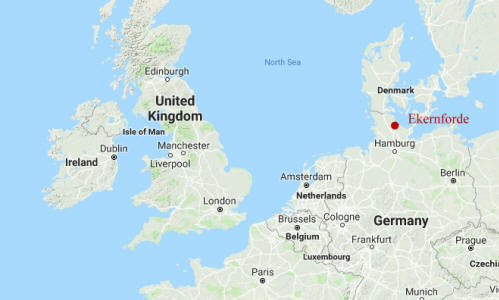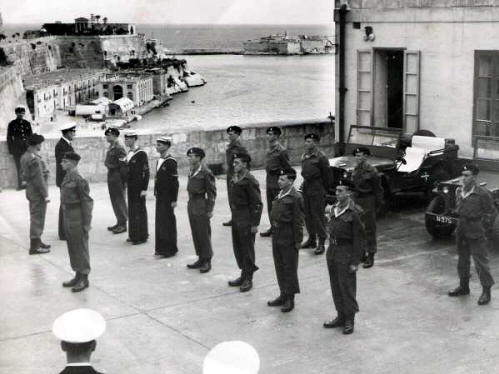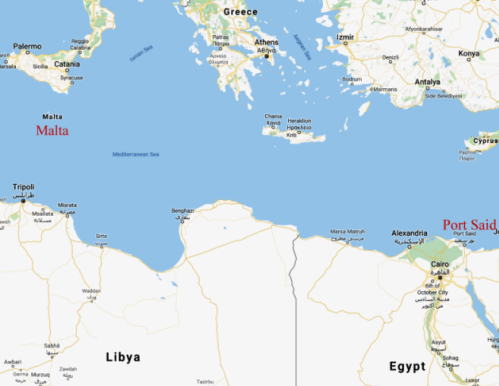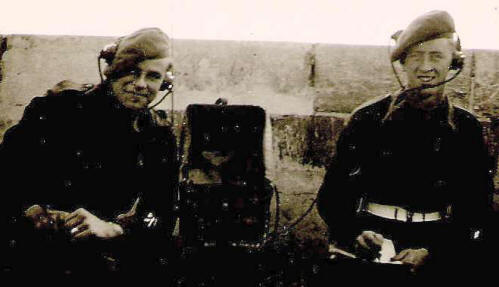Post WW2 Combined
Operations.
Ekernforde,
Germany 1947 to 1950
and Suez 1956
 Background Background
Amphibious landing training exercises continued
after the war, in this case at Ekernforde in
Schleswick Holstein in northern Germany in early 1948.
[Map courtesy of Google. 2019].
I joined the Army RASC (DUKW) section
from D-Day
until 1950. I did several jobs with DUKWs (amphibious front wheel drive
utility trucks) prior to starting at the
training school in Eckernforde. It was in 1947 that I first attended the Amphibious
Training School at Eckenforde
north Germany, where we practiced landing craft operations with LSTs (Landing
Ship Tank) and LCTs (Landing Craft Tank) generally
but mainly with LCT 4099 and an LST believed to
 be LST 3158 SULVA The photos that follow
were taken during training exercises with these craft, mainly in loading and
unloading. be LST 3158 SULVA The photos that follow
were taken during training exercises with these craft, mainly in loading and
unloading.
All the photos were taken on Combined Operations manoeuvres at Ekernforde in
Schleswick Holstein in northern Germany in early 1948. I'm not certain if the Combined Operations Insignia was still worn at this time. It was certainly in
use at the Rhine crossing in Germany, when LCIs (Landing Craft Infantry) were transported
overland on tank transporter trailers to
the banks of the River Rhine. This was on the 23 rd of March 1945.
What happened to the boats or crew as we went forward, I don't know.
[Photo; Ralph Marsh with a Neptune tank].
As the Sergeant in charge, one of my last
jobs was to take three DUKWs down to Hamburg, where we loaded Sunderland flying
boats with supplies on the river Elbe as part of the Berlin airlift operation
of 1948 -1949. The Russians had closed the land corridor to Berlin and the
airlift was the only way to supply those sectors of Berlin under the control
of the United States, the UK and France. I was later put on detail to go to Korea but I'd had enough of war so I
came home.
Acknowledgments
Written by Ralph Marsh who also provided the photographs.
Post WW2 Combined
Operations - Suez 1956
Operation Musketeer, the invasion of Suez in 1956, was the first British Combined
Operation to use helicopters in support of an amphibious landing. These are A
(Buster) Milham's recollections of the operation.
Conscription and Training
 In 1946, I was
conscripted into the army as required by the Government of the day. After basic
training in Howe Barracks, Canterbury, I was posted to a Signal Training Regiment
at Barnard Castle in County Durham, where I qualified as a Regimental Signaller in the Royal
Artillery. In 1946, I was
conscripted into the army as required by the Government of the day. After basic
training in Howe Barracks, Canterbury, I was posted to a Signal Training Regiment
at Barnard Castle in County Durham, where I qualified as a Regimental Signaller in the Royal
Artillery.
From there I was posted to the School of Combined Operations at
Remington, North
Devon, which was concerned with beach intelligence, training, mounting and
communications. I trained in high speed Morse code, undertook a
naval gunnery course at Whale Island, Portsmouth and a naval radar course at an
establishment nearby. By then, I was trained to
establish radio communications with
any ship on stand by, to supply naval gunfire support to any army unit
ashore and to relay fire orders to correct the fall of shot (shells) until on
target.
I was also a
signals instructor for 20 of my 22 years service.
[Photo;
author in Winter uniform].
Combined Operations Bombardment Unit (COBU),
Malta
In November 1947, four of us were posted to Malta to
form a new Combined Operations Bombardment Unit (COBU) under the command of two
officers, who were already stationed on the Island. The officers had been in COBUs during
the war, seeing much action in Europe and the Far East. The senior of the two was awarded the Croix de Guerre by the French
Government for his
services in France.
We lived in the Royal Naval Barracks, Camarata,
situated in the island's capital, Valletta. It remains there to this day but now occupied by the local
Maltese. The old nameplate is still in place over the door but with the RNB
removed. From that point on our accommodation was always with the Navy, either on shore bases
or aboard ships. I preferred the former, since I was sick on every ship I ever slept
on!
Living and working with the Navy, we learned new technology and
terminology to conform with naval standards and Navy communication
procedures. The role of our Battery was to produce naval gunfire
support for landed infantry moving forward, until conventional artillery could get ashore. To
achieve this, our Battery was organised into several forward observation
parties, each comprising an Officer (normally a Captain), a Technical
Assistant Royal Artillery (TARA), a Royal Naval Telegraphist and two Artillery
signallers, making 5 members in all. In layman's terms, we provided gunners with
information on targets and feedback on the accuracy of their shelling, to allow
them to make adjustments where necessary. Accurate shelling was obviously a good
thing in military terms but it also helped reduce collateral damage to civilians and their
property, especially in built up areas.
 More training took place at the Naval Signal School at Fort
Ricasoli on the side of the Grand Harbour of Valletta. This training included
visual signalling and pennant recognition and increased
Morse speed to 30 wpm to allow us to take the trade test at 25 wpm on a typewriter.
Visual Signalling involved sending
Morse by means of a hand held Aldis Lamp or a 10 inch or 12 inch lamp situated on
the bridge of a ship.
A later version, used by the Army in India and other sunny countries, used a
mirror to reflect the sun's rays. More training took place at the Naval Signal School at Fort
Ricasoli on the side of the Grand Harbour of Valletta. This training included
visual signalling and pennant recognition and increased
Morse speed to 30 wpm to allow us to take the trade test at 25 wpm on a typewriter.
Visual Signalling involved sending
Morse by means of a hand held Aldis Lamp or a 10 inch or 12 inch lamp situated on
the bridge of a ship.
A later version, used by the Army in India and other sunny countries, used a
mirror to reflect the sun's rays.
[Photo
opposite; annual
inspection in 1949 taken in the car park at the Lascaris Signal Station in
Malta.
I'm wearing two stripes next to the two Naval Telegraphists.
The Officer standing at the front of the Troop was Capt McQueen who retired
as a Major General some years later. In 2004 I wrote him a letter and
received a reply not long before he died. The other officer was Capt.
Mann-Thomson, who was the Commanding Officer. Both were in Combined
Operations during the war].
A confidential report
for 1949-50 commented about the author... A fine NCO who carries out his
duties (Troop NCO, pay clerk, signalling instructor, driving instructor and
Quartermaster) in an efficient and capable manner. It was a demanding and
sometimes exhausting work schedule.
Our training allowed any one of the team to provide reliable
information to the gunners, even if the unit was reduced in strength to one man as a result of
enemy action. However, under normal operating conditions, the Officer was responsible for
controlling the naval gunfire and guiding the shells onto the target being
engaged. These naval guns were normally of a 4.5 inch or 6 inch calibre,
depending on the type of ship.
Suez
At the time of Suez,
we were in HMS Phoenicia situated on Manoel Island in Valetta harbour and attached to 3 Commando Brigade
for operational purposes. The unit's name had changed over the years and in 1956
it was the 166 Amphibious Observation Battery RA. The designation 'Battery' was an exaggeration, as we never had more than 25 on strength compared to around
200 personnel in a conventional Artillery Battery. For the Suez operation we
received reinforcements from our Headquarters in the UK and from our sister unit
in Hong Kong.
By late October 1956, I was stationed with the Royal Artillery on
Malta as a sergeant but soon to become a Warrant Officer. The Suez crisis
created a surge in training in landing craft operations, especially embarking and
disembarking from LCAs (Landing Craft Assault), which were lowered from davits
on mother ships, similar to those used today for life boats on ferries.
Each LCA carried 32 men and the
normal procedure was for us to climb aboard before the craft was lowered into
the sea. I remember one occasion when we were lowered by an inexperienced crew
who had to contend with fairly rough seas and winds. These unpredictable forces
caused our LCA to crash into the side of the
mother ship on its way down. Once in the sea, we were directed to our position in the line of assault
craft by a Naval Officer with a megaphone onboard the control ship. His orders
were picked up by the Royal Coxswain of our LCA. The Coxswain replied, initially
in a low voice, with some choice Anglo Saxon expletives! These were
followed by a louder response informing the control officer that we
were sinking! We had sprung a leak from the damage caused in lowering the craft
and immediately returned to the mother ship to be lifted clear of the water. We
retrieved the LCA just in time and it took almost
24 hrs for the sea water to drain out. We were fortunate to avoid fatalities,
especially since, I for one, could not swim!
On the 31st October we embarked on the LST Lofoten (Landing Ship Tank.)
The other five parties in our group were dispersed to
other ships. The voyage of around 1,200 nautical miles (1350 miles) took 6 days and the LST anchored off Port Said. At around 0500 hrs
on the 6th November we boarded our LCA. About half an hour earlier we were informed that
we were up against the Egyptian Army. Once lowered into the sea, we formed up for
the run in and found ourselves in the first wave
along with 40 and 42 Commando Royal Marines, some in LCAs and others in LVTs
(Landing Vehicle Tracked). 45 Commando went in by helicopters, thus making this
the first Amphibious/Helicopter assault in the world. During this period, we were
shelled from ashore but luckily no craft were hit.
[Map courtesy of Google. 2019].
 The
Landing The
Landing
As the ramps went down, we disembarked into waist deep water with
some trepidation. As we waded ashore, we pushed aside pieces of wood and other
burning debris floating on the surface. We had no idea what was facing us but
luckily the enemy's T 34 Soviet made tanks, which were lined up at the top of
the beach, had been abandoned. On reaching the shore, we passed a number of beach
huts which were on fire. There were explosions from time to time and we
convinced ourselves that the huts contained ammunition. Much to our chagrin, we
later discovered that the 'lethal' contents of the huts were bottles of soft
drinks blowing up in the heat! Some of the huts were beach cafes, hurriedly
abandoned as we approached the area.
I was heavily laden with equipment as I ran up the beach -
sub machine gun, two hand grenades, six magazines of ammunition and a radio on
my back. A voice came over the radio from one of the other parties still to land
asking if the beach was mined. This rather slowed down our progress since we
hadn't given the possibility of mines much thought. Amidst all this mayhem, one
of the locals stood at the top of the beach shouting, "Haircut Johnny?"
- the one
comical episode of the whole operation.
We established an observation post in a French Lycee (school), which
had been the Headquarters of the Egyptian garrison in Port Said. After a
while, a group of Marines came in with an Egyptian Brigadier
General, who had been the garrison commander. Without any warning or hesitation
my CO, a Major, embraced the Brigadier like a long lost friend. They had been on the
same gunnery course in England some years earlier. Such is war!
Later in the morning I ventured outside to see what the situation
was and almost immediately I was knocked backwards by the impact of a bullet
hitting my hand and severing tendons. I was sent to the RAP (Regimental Aid Post),
which had been set up in the Casino Palace Hotel. On entering the RAP
my arms and ammunition were taken from me, so I felt quite naked as fighting
was going on all around the hotel. While waiting for first aid, some Egyptians,
to the rear of the property, were shooting at the casualties lying inside the RAP.
Our troops chased them off before any of
our wounded were hit.
 After
patching up, I made my way to the evacuation point not far from De Lessop’s
statue, where the bodies of three dead Marines were laid out to be collected. They were covered in blankets with
just their boots showing. Strangely, I was most struck by how still they
were, despite knowing that they were dead.
I also remember their sand covered boots and thinking that these poor
devils were running up the beach with me just a few hours previously. After
patching up, I made my way to the evacuation point not far from De Lessop’s
statue, where the bodies of three dead Marines were laid out to be collected. They were covered in blankets with
just their boots showing. Strangely, I was most struck by how still they
were, despite knowing that they were dead.
I also remember their sand covered boots and thinking that these poor
devils were running up the beach with me just a few hours previously.
[Photo;
the
author (left) and Jock Gibson operating a No 68 wireless set as used in WW2. Taken on the roof
of RNB. Camarata, Valletta, Malta].
A passing Marine Captain stopped to say how sorry he was that I had
been wounded and wished me all the best. Some hours later he was shot in the
head – but I never found out whether he survived or not.
Casualties for this operation were 22 killed and around 100 wounded. A Wessex
helicopter eventually picked me up and conveyed me to HMS Ocean, an
aircraft carrier part of which had been converted to hospital wards. I shared
the chopper with three more seriously wounded Egyptian soldiers and the thought
crossed my mind that they could overpower me and decant me into the sea.
I was later shipped out to Malta for surgery under
the supervision of medical staff known as sick berth attendants. They did a
marvellous job. At one stage I was destined to return to the UK for treatment
and convalescence but I persuaded the officers concerned that I should remain in
Malta where my family were. Apparently Army casualties went to the UK and Navy
to Malta. I made the case that I was as much Navy as I was Army!
On arrival in Malta, I was taken by ambulance to the
British Military Hospital, Imtarfa, at the northern end of the
Island. I was operated on and had a plaster cast fitted. Because of the
number of casualties, one of the maternity wards for service wives was emptied for us.
When my wife visited me for the first time there were three or four very pregnant women sitting on my bed sharing their grapes and
chocolates! After about a week I was
discharged and reported back to my unit.
Two or three weeks later, I received a
bill for the weapons and ammunition I had "LOST" in Suez! This pleased me no
end as you can imagine. After calming down I was informed that it was normal
army procedure for writing off these items, although, in practice they would
have been returned to an ordnance depot somewhere.
For being involved in this action I was awarded a General
Service Medal with a 'Near East' clasp.
Further Reading
Thank you and well done on an excellent website. I
would recommend a book published in 1947 by the Bombardment Units Association
entitled "Soldier, Sailor" compiled by Geoffrey Sanders with a forward by
Major-General R. E. Laycock, C.B, D.S.O. I have my father's copy and it gives an
invaluable insight into C.O.B.U. It has long been out of print but a search of
2nd hand bookshops should throw up an odd copy. David Gaskin (Check book
availability on the 'Books' link below and order on line if you wish).
There are around 300 books listed on our 'Combined Operations Books' page
which can be purchased on-line from the Advanced Book Exchange (ABE) whose
search banner checks the shelves of thousands of book shops world-wide. Type in
or copy and paste the title of your choice or use the 'keyword' box for book
suggestions. There's no obligation to buy, no registration and no passwords.
Click 'Books' for more
information.
 Acknowledgments Acknowledgments
Operation Musketeer, the invasion of Suez, was
written by A Milham (Buster).
|

 be LST 3158 SULVA The photos that follow
were taken during training exercises with these craft, mainly in loading and
unloading.
be LST 3158 SULVA The photos that follow
were taken during training exercises with these craft, mainly in loading and
unloading. In 1946, I was
conscripted into the army as required by the Government of the day. After basic
training in Howe Barracks, Canterbury, I was posted to a Signal Training Regiment
at Barnard Castle in County Durham, where I qualified as a Regimental Signaller in the Royal
Artillery.
In 1946, I was
conscripted into the army as required by the Government of the day. After basic
training in Howe Barracks, Canterbury, I was posted to a Signal Training Regiment
at Barnard Castle in County Durham, where I qualified as a Regimental Signaller in the Royal
Artillery.



